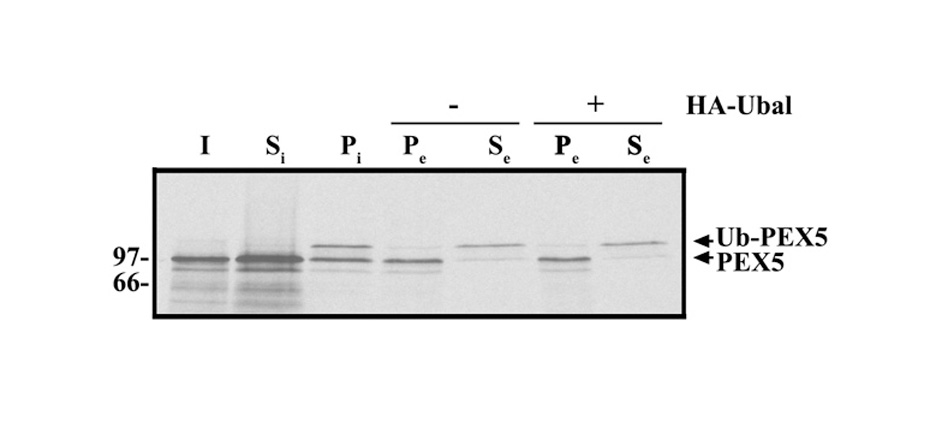Organelle Biogenesis & Function
ABOUT
Our group studies the molecular mechanisms of peroxisomal biogenesis, a process affected in several human genetic disorders. Our main focus is on a group of proteins which comprise the peroxisomal matrix protein Import machinery (PIM). These proteins include the RING finger peroxins (PEX2, PEX10 and PEX12) and other components of the ubiquitin-conjugating cascade (e.g., E2D1/2/3), ATPases of the AAA family (PEX1 and PEX6) as well as a group of proteins that comprise the peroxisomal protein translocon (e.g., PEX13 and PEX14). Thus, the general goal is not only to understand how newly synthesized (cytosolic) peroxisomal proteins are recognized, and translocated across the peroxisomal membrane in an already folded conformation, but also to contribute to a better understanding of the mechanisms used by AAA ATPases to remodel protein complexes and how protein activity can be modulated by transient ubiquitination. More recently, we are also interested in understanding the mechanisms of redox homeostasis in peroxisomes. We mainly use biochemical approaches to address these topics and we have developed a powerful cell-free in vitro system that recapitulates all the steps of peroxisomal protein import pathway.
RESEARCH
In the last years, our group has made several important findings. One regards the conclusion that PEX5, the shuttle receptor for newly synthesized peroxisomal matrix proteins, is also a chaperone/holdase that binds its cargoes in the cytosol inhibiting their oligomerization. This finding, together with the observation that the monomeric versions of some peroxisomal proteins are far better substrates for the PIM than the corresponding oligomeric versions, argues against the long-proposed concept that peroxisomal proteins are imported into the organelle matrix already in their oligomeric native state.
In another study, the nature of the peroxisomal protein translocon was addressed. In contrast to current models claiming that PEX5 is a pore-forming toxin-like protein that becomes inserted into the peroxisomal membrane during the protein transport process, we found evidence suggesting that the peroxisomal protein translocon is actually the so-called docking/translocation module (a complex comprising PEX2, PEX10, PEX12, PEX13 and PEX14) which forms a large hydrophilic cavity into which PEX5 enters to release its cargoes.
Finally, new mechanistic data on PEX1 and PEX6 were also obtained. We demonstrated that DTM-embedded monoubiquitinated PEX5 is the bona fide substrate for these AAA ATPases and that PEX5 is globably unfolded during the ATP-dependent dislocation event, re-enforcing the idea that these mechanoenzymes unfold substrates using a processive threading mechanism.

Team
Selected Publications
Noncanonical and reversible cysteine ubiquitination prevents the overubiquitination of PEX5 at the peroxisomal membrane. PLoS Biology22(3):, 2024. [Journal: Article] [CI: 1] [IF: 7.2]
DOI: 10.1371/journal.pbio.3002567 SCOPUS: 85187686049
Ferreira M.J., Rodrigues T.A., Pedrosa A.G., Silva A.R., Vilarinho B.G., Francisco T., Azevedo J.E.
Glutathione and peroxisome redox homeostasis. Redox Biology67:, 2023. [Journal: Review] [CI: 39] [IF: 10.7]
DOI: 10.1016/j.redox.2023.102917 SCOPUS: 85173675911
Ferreira M.J., Rodrigues T.A., Pedrosa A.G., Gales L., Salvador A., Francisco T., Azevedo J.E.
The mammalian peroxisomal membrane is permeable to both GSH and GSSG – Implications for intraperoxisomal redox homeostasis. Redox Biology63:, 2023. [Journal: Article] [CI: 18] [IF: 10.7]
DOI: 10.1016/j.redox.2023.102764 SCOPUS: 85160316858
Pedrosa A.G., Francisco T., Rodrigues T.A., Ferreira M.J., van der Heden van Noort G.J., Azevedo J.E.
The Extraction Mechanism of Monoubiquitinated PEX5 from the Peroxisomal Membrane. Journal of Molecular Biology435(2):, 2023. [Journal: Article] [CI: 9] [IF: 4.7]
DOI: 10.1016/j.jmb.2022.167896 SCOPUS: 85145598058
Ali M., Khan S.Y., Rodrigues T.A., Francisco T., Jiao X., Qi H., Kabir F., Irum B., Rauf B., Khan A.A., Mehmood A., Naeem M.A., Assir M.Z., Shahzad M., Abu-Amero K.K., Akram S.J., Akram J., Riazuddin S., Riazuddin S., Robinson M.L., Baes M., Azevedo J.E., Hejtmancik J.F., Riazuddin S.A.
A missense allele of PEX5 is responsible for the defective import of PTS2 cargo proteins into peroxisomes. Human Genetics140(4):649-666, 2021. [Journal: Article] [CI: 5] [IF: 5,9]
DOI: 10.1007/s00439-020-02238-z SCOPUS: 85098511203
Barros-Barbosa A., Rodrigues T., Ferreira M., Pedrosa A., Teixeira N., Francisco T., Azevedo J.
The intrinsically disordered nature of the peroxisomal protein translocation machinery. FEBS Journal286(1):24-38, 2019. [Journal: Article] [CI: 20] [IF: 4,4]
DOI: 10.1111/febs.14704 SCOPUS: 85057835122
Pedrosa A.G., Francisco T., Bicho D., Dias A.F., Barros-Barbosa A., Hagmann V., Dodt G., Rodrigues T.A., Azevedo J.E.
Peroxisomal monoubiquitinated PEX5 interacts with the AAA ATPases PEX1 and PEX6 and is unfolded during its dislocation into the cytosol. Journal of Biological Chemistry293(29):11553-11563, 2018. [Journal: Article] [CI: 40] [IF: 4,1]
DOI: 10.1074/jbc.RA118.003669 SCOPUS: 85050390152
Francisco T., Rodrigues T., Dias A., Barros-Barbosa A., Bicho D., Azevedo J.
Protein transport into peroxisomes: Knowns and unknowns. BioEssays39(10):, 2017. [Journal: Review] [CI: 63] [IF: 4,4]
DOI: 10.1002/bies.201700047 SCOPUS: 85029926379
Dias A.F., Rodrigues T.A., Pedrosa A.G., Barros-Barbosa A., Francisco T., Azevedo J.E.
The peroxisomal matrix protein translocon is a large cavity-forming protein assembly into which PEX5 protein enters to release its cargo. Journal of Biological Chemistry292(37):15287-15300, 2017. [Journal: Article] [CI: 26] [IF: 4]
DOI: 10.1074/jbc.M117.805044 SCOPUS: 85029471726
Rodrigues T., Francisco T., Dias A., Pedrosa A., Grou C., Azevedo J.
A cell-free organelle-based in vitro system for studying the peroxisomal protein import machinery. Nature Protocols11(12):2454-2469, 2016. [Journal: Article] [CI: 13] [IF: 10]
DOI: 10.1038/nprot.2016.147 SCOPUS: 84996598602

